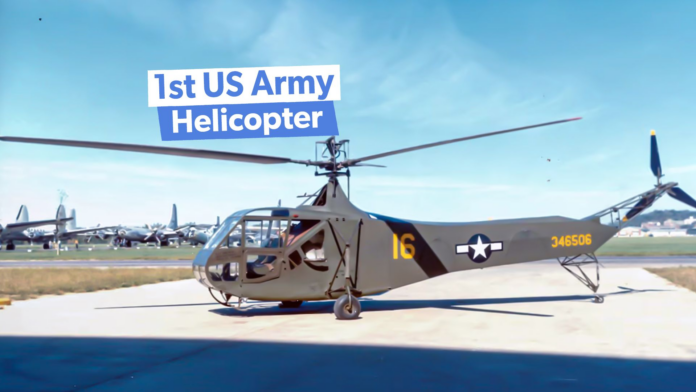The Sikorsky R-4, one of the world’s first mass-produced helicopters, became a pioneering design that helped set the stage for generations of development of military helicopters. The aircraft was initially developed by Igor Sikorsky during the Second World War and featured a single primary rotor with three blades that was powered by a practical and easy-to-fix radial engine.
Photo: NASA Langley
The aircraft’s lightweight nature allowed it to be extremely versatile, making it ideal for both combat operations and search-and-rescue missions. The Sikorsky R-4 first took to the skies in January 1942, and it expanded upon the capabilities of the experimental VS-300, a helicopter that served as a feasibility demonstrator for the potential military and civilian capabilities of rotary-wing aircraft.
Get all the latest aviation news from Simple Flying!
A valuable aircraft that proved its worth and served with both the US
With a two-seat cockpit, the R-4 was capable of performing several tasks that would be unfeasible for fixed-wing aircraft, which were forced to continue moving at all times. The aircraft’s versatility proved to be a major asset for military organizations, and the United States Army Air Forces, Navy, and Coast Guard would all use the helicopter throughout the conflict. The Royal Air Force (RAF) and Royal Navy would also both use the helicopter extensively throughout the war.
While the R-4 designation was exclusively used by the United States Army Air Forces (the precursor to the modern United States Air Force), the Navy and Coast Guard both designated it as the HNS-1 and the British referred to the aircraft as the Hoverfly. This moniker would be the one that stuck with the helicopter for the longest time, as it demonstrated the level of utility provided by a novel light-flying machine that could hover above the ground.
Related What Is The US Coast Guard’s Most Widely Used Helicopter? The United States Coast Guard (USCG) operates two types of helicopters: the Sikorsky Medium Range Recovery MH-60T Jayhawk and the Short Range Recovery
Throughout the conflict, the R-4 would prove its worth in dozens of medical evacuations and search-and-rescue missions, even serving in some reconnaissance roles. The aircraft performed the first in-theater combat rescue in 1944 when it saved a pilot who had been shot down over the dense jungles of Burma.
Despite its relatively small size and some issues related to its in-theater reliability, the aircraft was used extensively and would lay the groundwork for generations of helicopters to follow. The aircraft’s designer, Igor Sikorsky, would go on to found one of the largest helicopter producers in history. Let’s take a deeper look at the story of the R-4 Sikorsky, examining its design, development, and operational history.
The aircraft’s development process followed an uncharted path
The Sikorsky VS-316, which was developed from earlier experimental aircraft, was designated as the XR-4 when the United States Army Air Forces decided it wanted a prototype rotorcraft of its own. The aircraft first took to the skies on January 14th, 1942, and would be accepted by the Army on the 30th of May of that year, after undergoing extensive flight testing.
Photo: United States Coast Guard
During tests, the aircraft completed a 761-mile cross-country flight, ascended to an altitude of over 12,000 feet, and hit speeds nearing 90 miles per hour. The Royal Air Force also wanted a light and versatile rotorcraft of its own, one that could operate off of its ships, and was so impressed by its performance in flight tests that it ordered a version for itself.
Related How Much Does The US Navy’s MH-60R Seahawk Cost? The MH-60R Seahawk costs around $40 million depending a number of factors – including spare parts, missiles, and services included.
The aircraft’s later prototypes would include more powerful engines, larger rotors, and other modifications that would enhance the rotorcraft’s inflight stability. Furthermore, auxiliary fuel tanks were added to make sure that the plane’s range could be extended to meet the demands of combat operations.
The aircraft would become popular with both the United States military and the British armed forces
By the time 1944 came around, United Aircraft, the company behind the R-4’s production at the time, had built its 100th helicopter, and production quickly accelerated to more than five helicopters a week, an impressive number even by wartime production standards. Here are some specifications for the Sikorsky R-4, according to the National Museum of the United States Air Force:
Category: Sikorsky R-4 Specification: Maximum operating speed: 75 miles per hour Service ceiling: 8,000 feet Typical range: 130 miles
Operational history and legacy
The Sikorsky R-4 leaves behind an impressive legacy in both military and (later) civilian applications, breaking ground for the helicopter industry. The aircraft was especially distinguished for its roles in rescue missions and achievements under extremely challenging combat circumstances.
Photo: National Museum of the United States Air Force
In January 1944, the first helicopter rescue in the United States was completed by Coast Guard Commander Frank Erickson, who successfully delivered blood plasma to those injured in the explosion of the USS Turner. Later missions would take place across the Asian theater, where combat left soldiers stranded and aircraft downed in the dense jungles of the region. According to the Warhawk Air Museum, the aircraft was also used extensively in India for search-and-rescue missions.
Other operations in the Pacific theater, such as Operation Ivory Soap, transported desperately needed aircraft parts and evacuated wounded soldiers, demonstrating the rotorcraft’s versatility and robust capabilities. The aircraft would later go on to serve in the Korean War, where, throughout a six-week operation, Lieutenant Louis Carle evacuated over 80 soldiers, according to Smithsonian Magazine.
Close
Despite its impressive success, the aircraft did have its drawbacks, with the helicopter facing maneuverability challenges at times, often created by excessive vibrations. Nonetheless, engineers would learn from the R-4’s struggles, and they would go on to build dozens of different helicopters that remain key elements of the United States Armed Forces’ combat and logistical capabilities today.



